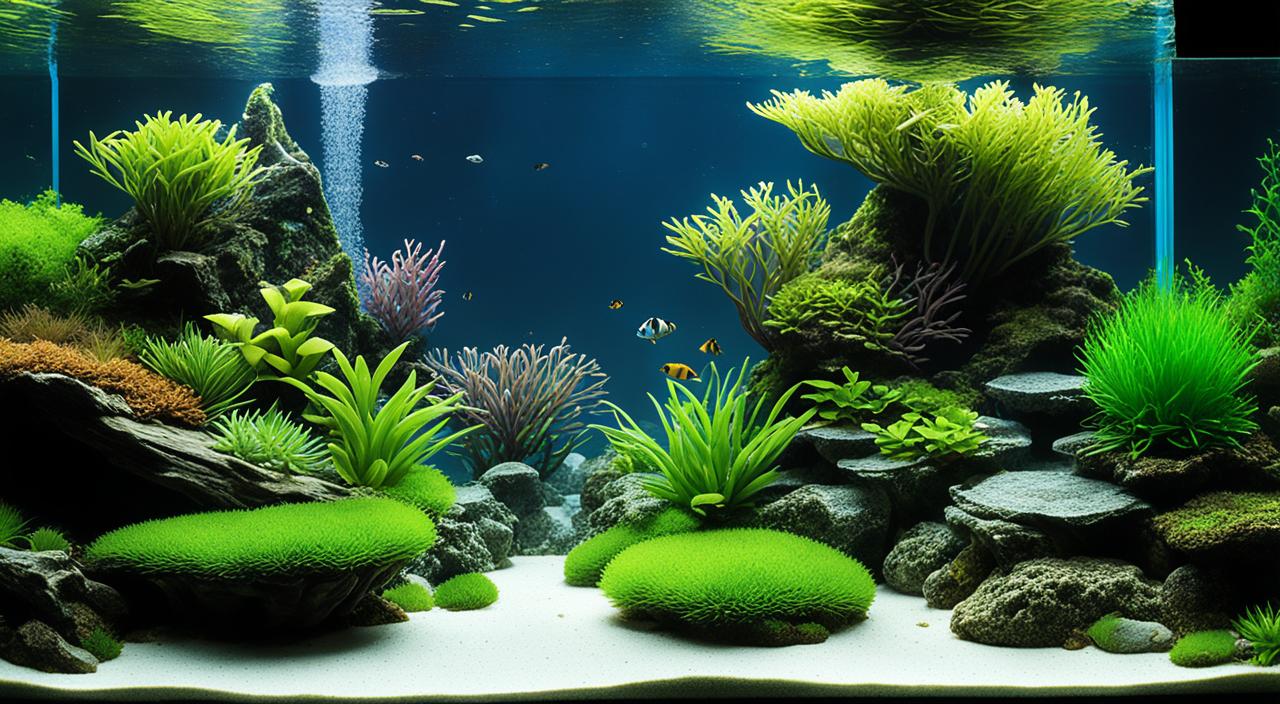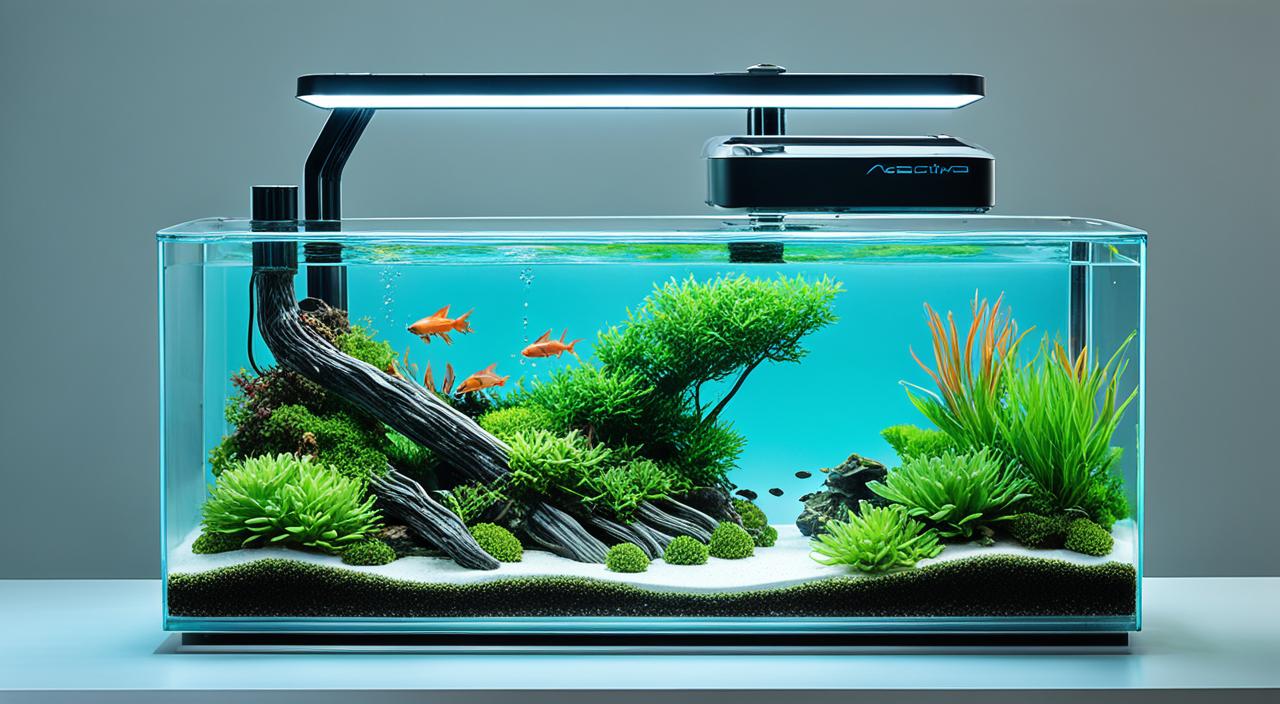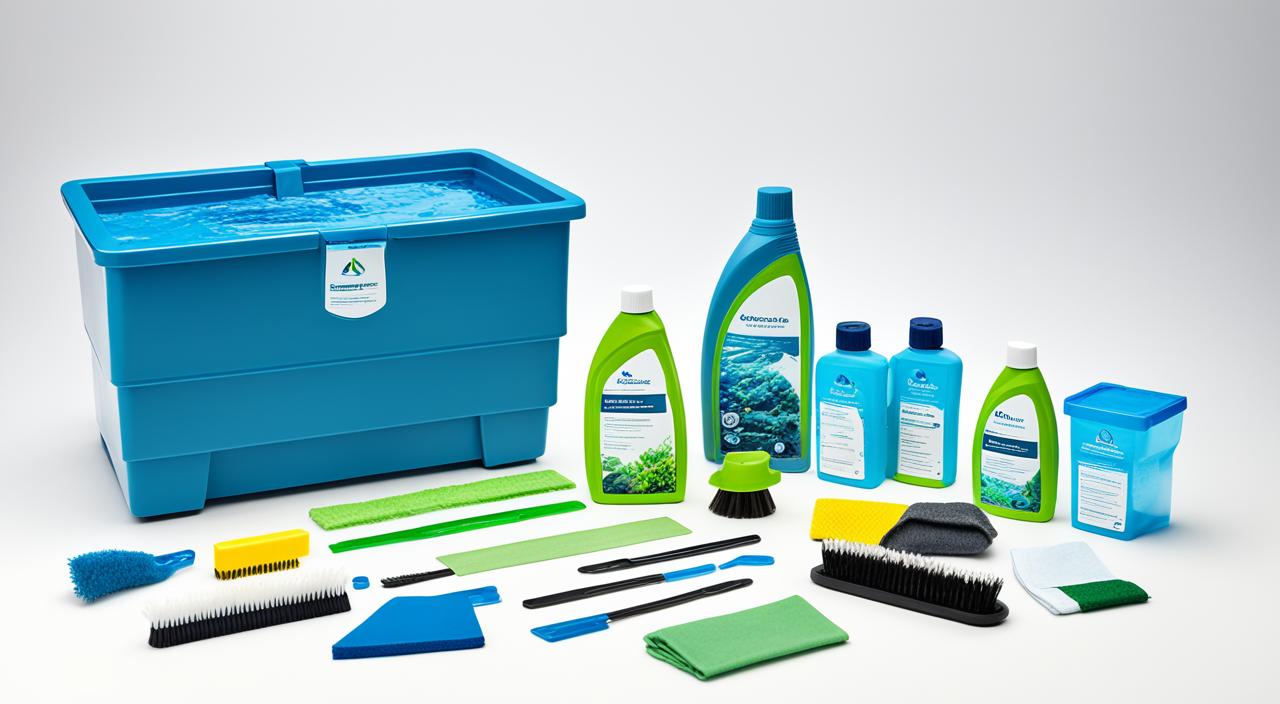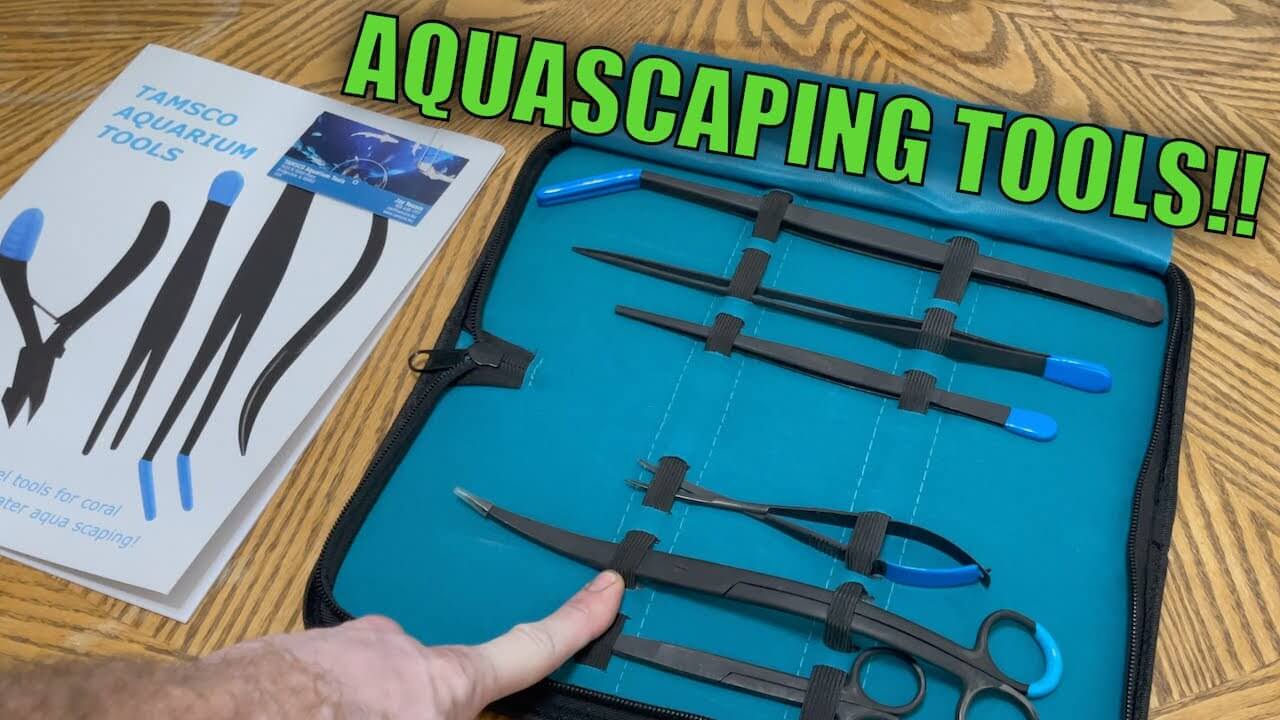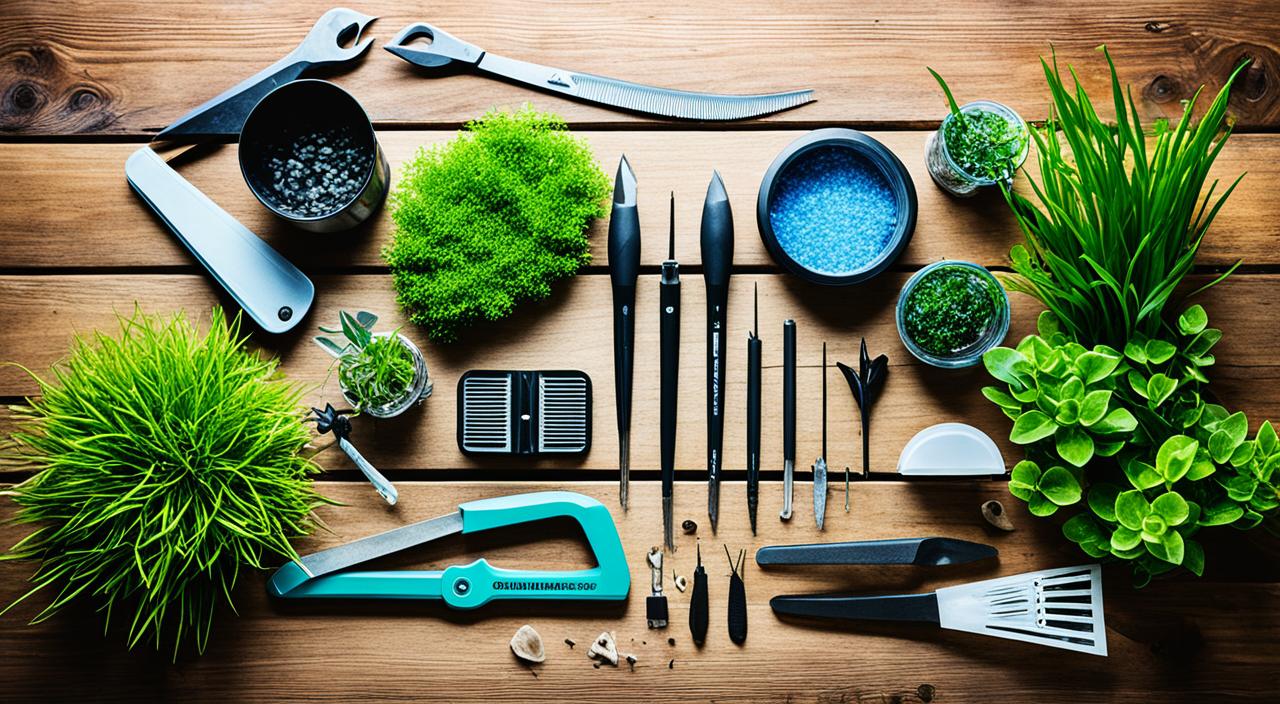Discovering the essential techniques and best practices in aquascaping can transform your aquarium from mundane to masterpiece. With the proper knowledge, every maintenance task becomes a step towards perfection. Dive in now and fear missing out no more.
Key Takeaways:
- Mastering aquascaping techniques and best practices can elevate your aquarium to a new level.
- Using the right tools is essential for achieving precision and efficiency in aquascaping tasks.
- Proper plant care techniques help maintain a balanced and visually appealing plant layout.
- Arranging hardscape materials strategically creates a captivating and stable aquascape.
- Effective substrate management promotes the health and visual impact of your aquascape.
- Maintaining your aquarium regularly ensures a healthy and vibrant aquascape.
Unlock the full potential of your aquatic garden with expert tips and tricks. Our Essential Guide to Aquascaping Tools is your key to creating mesmerizing aquascapes.
Understanding Aquascaping Tools
Aquascaping requires various tools to shape and maintain the aquatic landscape. These tools ensure precision and efficiency in creating your underwater masterpiece. Let’s dive deeper into the world of aquascaping tools and learn how to make the most of them.
Overview of Essential Tools for Aquascaping
When it comes to aquascaping, there are several tools that every aquarist should have in their arsenal. These tools include:
- Scissors: Ideal for trimming and shaping aquatic plants, mainly stem plants.
- Tweezers: Used for planting and arranging small aquatic plants, such as carpeting plants.
- Substrate rake: Helps level and maintain the substrate, ensuring proper plant growth.
- CO2 diffuser: Essential for supplying carbon dioxide to aquatic plants, promoting healthy growth.
These tools will enable you to carry out essential aquascaping tasks effectively and achieve the desired results.
Tips for Selecting the Right Tools for Different Tasks
Not all aquascaping tasks require the same tools. It’s essential to choose the right tools based on the specific task at hand. Here are some tips to help you select the appropriate tools:
- Consider the plant types: Different plants may require different tools for planting and maintenance. Curved tweezers are ideal for delicate planting, while long scissors are more suitable for trimming tall-stem plants.
- Quality matters: Invest in high-quality tools that are built to last. They will ensure precise and efficient results, saving you time and effort in the long run.
- Ergonomics and comfort: Look for comfortable tools to hold and use for extended periods. This will prevent hand fatigue and allow you to focus on the task at hand.
You can easily carry out aquascaping and achieve professional-level results by selecting the right tools for different tasks.
Plant Care Techniques
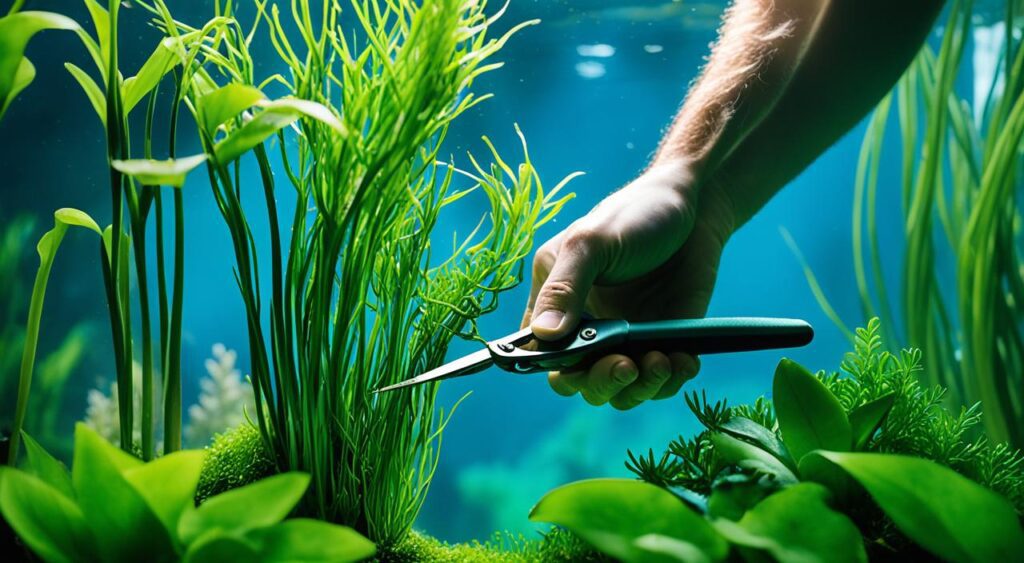
Proper plant care is essential for your aquascape’s health and visual appeal. In this section, I will cover techniques for planting, pruning and maintaining aquatic plants and strategies for creating a balanced and aesthetically pleasing plant layout.
How to Properly Plant, Prune, and Maintain Aquatic Plants
When planting aquatic plants, it’s essential to consider the proper depth and spacing. Plants should be inserted into the substrate at a depth that allows their roots to anchor securely while ensuring enough access to light and nutrients. Proper spacing between plants is also crucial to prevent overcrowding and resource competition.
Pruning is necessary to maintain the desired shape and prevent overgrowth in your aquascape. Use sharp aquatic plant scissors to trim any excess or dead foliage. When pruning stem plants, it’s essential to trim them above the node to encourage bushier growth.
Maintaining aquatic plants involves providing proper care and creating the ideal environment. This includes providing adequate lighting, CO2 supplementation (if necessary), and regular fertilization to ensure optimal growth and health.
Strategies for Creating a Balanced and Aesthetically Pleasing Plant Layout
Creating a balanced and visually appealing plant layout involves considering various factors such as height, texture, and colour. Incorporating plants with different heights can add depth and create a layered effect in your aquascape. Mixing plants with different textures, such as fine-leaved and broad-leaved plants, adds visual interest and contrast.
Colour plays a vital role in creating an aesthetically pleasing aquascape. Consider using plants with different hues, ranging from vibrant greens to deep reds, to add visual impact and create focal points in your layout. Combining plants with contrasting colours can create a striking and captivating visual effect.
Consider each species’ growth patterns and requirements carefully and plan your plant placement. Placing taller plants in the background and shorter plants in the foreground can help create a sense of depth and perspective in your aquascape.
By mastering plant care techniques, you can ensure the health and beauty of your aquascape. Proper planting, pruning, maintenance, and thoughtful plant layout strategies will help you create a thriving and visually stunning underwater landscape.
Hardscape Arrangement Best Practices
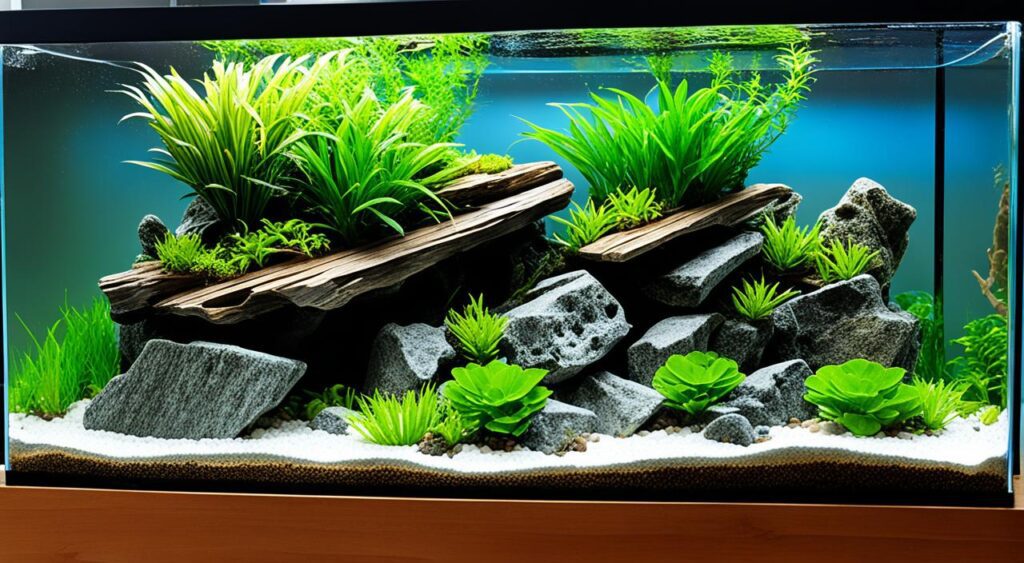
The arrangement of hardscape materials, such as rocks and driftwood, is crucial in creating a visually appealing aquascape. Proper selection and positioning of these materials can significantly enhance the overall aesthetics of your aquarium. Here, I will provide techniques and best practices for hardscape positioning to help you create a captivating and balanced layout.
Techniques for Selecting and Positioning Rocks, Driftwood, and Other Hardscape Materials
When choosing hardscape materials, consider their size, shape, and colour to create a harmonious and natural-looking aquascape. Large rocks can serve as focal points, while smaller stones or pebbles can be used to create depth and texture. Driftwood can add a touch of elegance and provide hiding spots for fish. Selecting aquarium-safe materials is essential, as some may leach harmful chemicals into the water.
When positioning hardscape materials, consider your aquascape’s overall layout and balance. Utilize the rule of thirds, placing focal points and key elements off-centre to create visual interest. Experiment with different arrangements and perspectives to find the most pleasing composition. Avoid clustering materials together or creating symmetrical patterns, as this can result in a less natural-looking aquascape.
How to Achieve a Natural Look and Ensure Stability in Your Layout
To achieve a natural look, mimic landscapes such as mountains, valleys, or riverbeds with your hardscape arrangement. Consider the natural habitat of the fish and plants in your aquarium, and try to recreate their native environment. This will create a more realistic and pleasing aquascape.
Ensuring stability in your layout is essential to prevent hardscape materials from shifting or toppling over. Securely anchor rocks and driftwood using aquarium-safe adhesives, silicone, or stainless-steel wires. This will help maintain the integrity of your aquascape and prevent any disruptions caused by movements or water flow.
| Benefits of Proper Hardscape Arrangement | Challenges of Improper Hardscape Arrangement |
|---|---|
| Creates a visually appealing aquascape | Unbalanced layout |
| Adds depth and texture to the aquatic environment | Hardscape materials shifting or toppling over |
| Provides hiding spots for fish | Aquascape looking unnatural or artificial |
| Enhances the overall aesthetics of the aquarium | Harms the health of aquatic plants and animals |
By following these hardscape positioning techniques and best practices, you can create a visually captivating and stable layout for your aquascape. Remember to consider hardscape materials’ size, shape, and colour, mimic natural landscapes, and ensure stability by securely anchoring the materials. Proper hardscape arrangement will transform your aquascape into a stunning underwater masterpiece.
Substrate Management
The substrate is a critical component of an aquascape, as it supports aquatic plants and contributes to the overall aesthetics of the layout. Proper substrate management techniques and best practices are essential for creating a thriving and visually stunning aquascape.
Tips for Choosing and Shaping the Substrate for Plant Health and Visual Impact
When selecting the substrate for your aquascape, it’s essential to consider several factors affecting plant health and visual impact. Here are some tips to guide you:
- Consider the nutrient content of the substrate. Different plants have varying nutrient requirements, so choose a substrate that provides the necessary nutrients for your selection.
- Pay attention to the particle size of the substrate. Fine particles are ideal for delicate plants with shallow root systems, while larger particles are suitable for robust plants with extensive root systems.
- Choose a substrate colour that complements the overall design of your aquascape. Light-coloured substrates can create a bright, airy look, while dark-coloured substrates provide a dramatic and contrasting backdrop.
- Shape the substrate to create depth and dimension in your aquascape. Create slopes, raised areas, or terraces to mimic natural landscapes and add visual interest.
By considering these tips, you can choose and shape the substrate to promote plant health and enhance the visual impact of your aquascape.
How to Prevent Common Substrate-Related Issues
Substrate-related issues can negatively impact the health and aesthetics of an aquascape. It’s essential to take preventive measures to avoid these problems. Here are some techniques:
- Avoid compacting the substrate, as it can restrict root growth and nutrient absorption. Gently stir the substrate occasionally to prevent compaction.
- Prevent the formation of anaerobic zones by ensuring proper water circulation and oxygenation within the substrate. Consider using porous substrates or adding root tabs to provide oxygen to the roots.
- Monitor and control nutrient levels in the substrate to prevent excessive algae growth. Regular water testing and adjustments can help maintain a balanced nutrient level in the aquascape.
These preventive measures will help you maintain a healthy and visually appealing aquascape by avoiding common substrate-related issues.
| Substrate Management Techniques | Benefits |
|---|---|
| Choose a substrate with the right nutrient content | Ensures plants receive adequate nutrients for healthy growth |
| Consider particle size when selecting the substrate | Matches the needs of different plants and their root systems |
| Select a substrate colour that enhances the overall design | Contributes to the aesthetic appeal of the aquascape |
| Create depth and dimension by shaping the substrate | Adds visual interest and mimics natural landscapes |
| Avoid compacting the substrate | Allows for healthy root growth and nutrient absorption |
| Prevent the formation of anaerobic zones | Ensures oxygen reaches plant roots and prevents root decay |
| Monitor and control nutrient levels in the substrate | Prevents excessive algae growth and maintains a balanced ecosystem |
Aquarium Maintenance Routines
Regular Maintenance Tasks and How to Efficiently Use Tools to Keep Your Aquarium Healthy
Regular aquarium maintenance is essential for the health and longevity of your aquascape. By following a consistent maintenance routine, you can ensure a thriving and visually appealing aquarium. In this section, I will highlight the key maintenance tasks and provide tips on using tools to efficiently keep your aquarium in optimal condition.
Regular Maintenance Tasks
To maintain a healthy aquarium, several tasks should be performed regularly:
- Water changes: Regular changes help remove accumulated toxins and replenish essential minerals and nutrients. Aim for a 20-30% water change every 1-2 weeks.
- Filter cleaning: Clean your filter regularly to remove debris and prevent clogging. Follow the manufacturer’s instructions for cleaning your specific filter type.
- Equipment maintenance: Check and clean your equipment, such as heaters and air pumps, to ensure they function correctly. Replace any worn-out or faulty equipment.
Efficiently Using Tools for Maintenance
The right tools can make aquarium maintenance tasks much easier and more efficient. Here are some tips for using tools effectively:
- Gravel siphon: Use a gravel siphon during water changes to remove debris from the substrate. Start from the bottom and work your way up, using gentle suction to avoid disturbing the plants and fish.
- Algae scraper: Use an algae scraper to remove algae buildup from the glass walls of the aquarium. Choose a scraper suitable for your tank size and material.
- Tweezers and scissors: Use long tweezers and scissors to trim and prune aquatic plants. This will help maintain their shape and prevent overgrowth.
Algae Control and Water Quality Management
Algae can sometimes become a challenge in aquariums, affecting water quality and the overall aesthetics of your aquascape. Here are some techniques for efficient algae control and water quality management:
- Controlling nutrient levels: Monitor and control nutrient levels in your tank, especially nitrates and phosphates. Regular water changes, proper feeding, and quality aquarium fertilizer can help maintain optimal nutrient levels.
- Balancing light intensity: Ensure the right balance of light intensity for your plants. Too much light can stimulate excessive algae growth, while too little can hinder plant growth. Use a timer to provide consistent and appropriate light duration.
- Implementing algae-eating species: Introduce algae-eating species, such as Siamese algae eaters or otocinclus catfish, to help control algae naturally. Ensure compatibility with your existing fish and plants.
| Algae Control Techniques | Effectiveness |
|---|---|
| Regular water changes | ✓ |
| Algae scraper | ✓✓ |
| Controlling nutrient levels | ✓✓✓ |
| Introducing algae-eating species | ✓✓✓✓ |
By implementing these techniques and best practices, you can maintain efficient algae control and ensure a healthy and vibrant aquascape.
Conclusion
Mastering essential aquascaping techniques and best practices is the key to creating a stunning and thriving underwater masterpiece. Understanding and applying these techniques can transform your aquarium into a captivating aquatic landscape.
First and foremost, using the right tools is crucial. Whether scissors are used for precise trimming, tweezers are used for delicate planting, or a substrate rake for maintenance, having the appropriate tools on hand will make aquascaping tasks more accessible and efficient.
In addition to using the right tools, caring for aquatic plants is essential. Properly planting, pruning, and maintaining these plants will ensure their health and contribute to the overall visual appeal of your aquascape. Balancing different plant heights, textures, and colours will create a harmonious and balanced layout.
Arranging hardscape materials, such as rocks and driftwood, is another crucial aspect of aquascaping. By selecting these materials thoughtfully and positioning them strategically, you can create a natural and visually pleasing aquascape while ensuring stability.
Furthermore, managing the substrate effectively is crucial. The suitable substrate, with proper nutrient content and particle size, will support the growth of aquatic plants and enhance the overall aesthetic of the layout. Avoiding common substrate-related issues, such as compacting and algae growth, will help maintain a healthy and vibrant aquascape.
Lastly, regular aquarium maintenance is critical to the long-term success of your aquascape. You can ensure a healthy and balanced aquatic environment by performing routine tasks such as water changes, filter cleaning, and equipment maintenance. Efficient algae control and water quality management techniques will also contribute to your aquascape’s overall health and beauty.
So, dive into aquascaping confidently, armed with these essential techniques and best practices. Unleash your creativity and create your underwater masterpiece by applying these principles. With dedication and attention to detail, you can achieve a stunning and thriving aquascape that will be the envy of all.
FAQ
What are some essential tools for aquascaping?
Some essential tools for aquascaping include scissors, tweezers, a substrate rake, and a CO2 diffuser.
How do I select the right tools for different tasks in aquascaping?
It’s important to choose tools that are appropriate for specific tasks in aquascaping. For example, long scissors are ideal for trimming stem plants, while curved tweezers are suitable for planting carpeting plants.
What techniques should I follow for planting and maintaining aquatic plants in my aquascape?
Proper plant care involves techniques such as planting at the right depth and spacing, pruning for shape and prevent overgrowth, and creating a balanced layout with varying heights, textures, and colors.
How should I select and position hardscape materials in my aquascape?
When arranging hardscape materials, consider factors such as size, shape, and color to achieve a visually appealing layout. To create a natural look, mimic natural landscapes, and ensure stability by securely anchoring the materials.
What are some tips for managing the substrate in an aquascape?
For optimal plant health and visual impact, choose the right substrate by considering nutrient content, particle size, and color. Manage the substrate to prevent common issues like compaction, anaerobic zones, and algae growth.
What are some regular maintenance tasks for an aquascape, and how can tools be used efficiently for these tasks?
Regular maintenance tasks for an aquascape include water changes, filter cleaning, and equipment maintenance. Using tools effectively, such as siphons and algae scrapers, can streamline and simplify these tasks.

